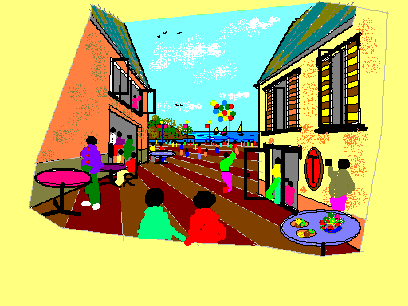|
Organic Real Estate Planning and Development
Stephen Chung Managing Director
Zeppelin Real Estate Analysis Limited
August 2005
Recently your humble author has read an article in the New York Times dwelling on the concept of ‘eminent domain’ and its use by some city mayors in the USA to assemble privately held land for subsequent macro-scale private real estate developments (by real estate developers) instead of public projects such as roads and highways. The writer questioned whether such practices are fair and whether such macro-scale developments are really beneficial to cities. He cited Portland as an example which CBD is now void and lifeless after office hours, and that some cities now face the challenge of having to entice formerly evicted small businesses and residents back into such city centers. This article reminded your author of his college days when once professors of urban planning urged us to take photos of ‘places’ that we thought to be reflective of Hong Kong. If memory serves me right, most of us took pictures of the (then) prominent Grade A office buildings (mostly in Central) and so on. While this was understandable, our professors asked why none of us took pictures of small street scenes, wet markets, tai-pai-dongs, and the like, which showed how common folks thrived. We learnt the meaning of “human scale” and “organic growth” in architecture and urban planning terms. Using the above, there are broadly 2 types (ends) of urban landscape: (a) big macro almost monumental building blocks which are in many cases the result of ‘town plans’, and (b) small scale streetscape and developments which are likely to have evolved ‘organically’. Each type has its pros and cons and most sizable cities would contain both types. Nonetheless, it seems quite a few cities, especially ones associated with developing economies, and not to mention quite a few city governments, tend to favor the former i.e. large-scale urban development projects covering large tracts of land and involving several millions of square feet in floor space. This is quite understandable yet may produce the kind of lifeless environments (after dark) that other cities now dread. The following guides may help avoid such problems: A) Big does NOT necessarily mean Wastage = provided there is sufficient demand and the general ability to pay (in terms of rents etc) for the use of such facilities and properties, otherwise a white elephant may be born. One mistake many developing cities in developing economies commit is to copy outright what had been done in other (Western) cities without considering whether the volume, design, and scale are suitable. B) Small streetscape elements incorporated into big projects = e.g. the “Shing Tian Di” in Shanghai which is quite a big development project yet the developer had sought to incorporate many small design and planning features to give the place a more proportionate human scale with thriving street level interests. C) Architecture is NOT just form, the tangible bricks and mortar, or geometry, the ‘design concept’ (or even philosophy) counts as much = many developing cities seem to like copying the design of buildings and complexes that exist in Europe or the USA, and while some had been done successfully and tastefully, others have only copied the form but not the spirit behind. For instance, seeing a Roman fountain in Rome could be an enlightening experience, but building an exact one in an Asian city (real estate complex) could be somewhat ‘out of place’. In summary, your author does not mind (in fact likes) macro-scale projects, provided there is demand and the design talent to develop them competently. Note* = Hong Kong real estate prices dropped BY (not to) almost 70% from the 1997 peak levels to the mid 2003 troughs. Prices have since recovered some 60% on average. This steep drop was in part due to the HK$ to US$ peg (HK$7.78 = US$ 1.00) but that alone could not have explained the whole story.Notes: The article and/or content contained herein are for general reference only and are not meant to substitute for proper professional advice and/or due diligence. The author(s) and Zeppelin, including its staff, associates, consultants, executives and the like do not accept any responsibility or liability for losses, damages, claims and the like arising out of the use or reference to the content contained herein. |
Phone (852) 37576388 Fax (852) 37576399 E-mail contact@real-estate-tech.com
Address c/o Zeppelin, Unit 1007, 10/F, CCT Telecom Building, 11 Wo Shing Street, Shatin, NT, Hong Kong
Copyright rests with Zeppelin and/or relevant authors
